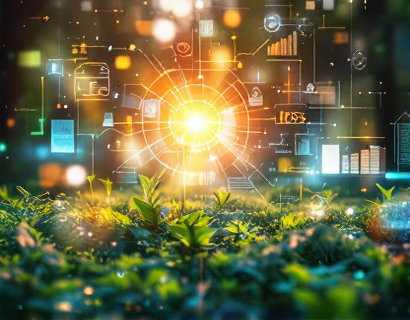Advanced Analytics for Sustainable Horticulture: Optimizing Resource Management and Enhancing Crop Yields with Data-Driven Insights
In the realm of horticulture and agriculture, the integration of advanced analytics represents a transformative shift towards more sustainable and efficient practices. By leveraging data-driven insights, farmers and horticulturists can optimize resource management, enhance crop yields, and contribute to environmental stewardship. This article delves into the critical role of advanced analytics in modern agriculture, exploring how these tools can revolutionize the way we grow food and manage natural resources.
Understanding Advanced Analytics in Agriculture
Advanced analytics in agriculture encompasses a broad range of technologies and methodologies designed to process and interpret large datasets. These include satellite imagery, IoT sensors, machine learning algorithms, and predictive modeling. The core objective is to transform raw data into actionable insights that can inform decision-making at every level of the agricultural supply chain.
Satellite imagery, for instance, provides high-resolution images of fields, allowing farmers to monitor crop health, soil moisture, and vegetation indices in real-time. IoT sensors embedded in the soil or attached to equipment collect data on temperature, humidity, and nutrient levels, offering a granular view of the growing environment. Machine learning algorithms analyze this data to identify patterns and predict outcomes, such as crop yields or the likelihood of pest infestations.
Optimizing Resource Management
One of the most significant benefits of advanced analytics in horticulture is the optimization of resource management. Traditional farming methods often rely on fixed schedules and uniform applications of water, fertilizers, and pesticides, which can lead to inefficiencies and environmental degradation. Data-driven approaches enable precision agriculture, where resources are applied exactly where and when they are needed.
For example, soil moisture sensors can detect variations in soil water content across a field, allowing for variable irrigation schedules. This ensures that some areas receive more water while others are conserved, reducing waste and improving water use efficiency. Similarly, nutrient sensors can monitor soil nutrient levels, enabling targeted fertilizer applications that prevent overuse and minimize runoff into waterways.
Advanced analytics also facilitate the optimization of energy use. By analyzing data from farm equipment and weather forecasts, farmers can schedule operations during optimal conditions, reducing fuel consumption and lowering emissions. This not only cuts costs but also contributes to a reduction in the carbon footprint of agricultural activities.
Enhancing Crop Yields
Enhancing crop yields is a primary goal of modern horticulture, and advanced analytics play a crucial role in achieving this objective. By providing detailed insights into crop health and growth conditions, farmers can make informed decisions that maximize productivity.
Vegetation indices derived from satellite imagery can indicate the health and vigor of crops, allowing for early detection of stress factors such as drought, disease, or nutrient deficiencies. Machine learning models can predict optimal planting and harvesting times based on historical data and current conditions, ensuring that crops are grown under the best possible circumstances.
Moreover, predictive analytics can forecast potential yield variations due to environmental factors, enabling farmers to take proactive measures. For instance, if a drought is predicted, farmers can implement conservation strategies or adjust irrigation schedules to mitigate the impact. This level of foresight is invaluable in a sector where weather and climate can significantly influence outcomes.
Promoting Sustainable Practices
The integration of advanced analytics in horticulture not only boosts efficiency and yields but also promotes sustainable practices. By reducing the overuse of resources such as water and fertilizers, these technologies help minimize environmental impact. Precision application of inputs ensures that only the necessary amounts are used, reducing the risk of pollution and preserving soil health.
Additionally, data-driven insights can support the adoption of regenerative agriculture practices. By monitoring soil health and biodiversity, farmers can implement practices that enhance soil fertility and ecosystem resilience. This holistic approach to farming not only improves crop yields but also contributes to long-term environmental sustainability.
Case Studies and Real-World Applications
Several case studies illustrate the tangible benefits of advanced analytics in horticulture. In one example, a large-scale vegetable farm implemented a system that combined satellite imagery, soil sensors, and machine learning to optimize irrigation and fertilization. The result was a 20% increase in crop yields and a 15% reduction in water usage. The farm also reported lower costs and improved soil health, demonstrating the multifaceted benefits of data-driven agriculture.
Another instance involves a fruit orchard that used drone-based imagery and AI to monitor tree health and detect early signs of disease. By identifying problem areas promptly, the orchard was able to treat issues before they spread, resulting in a 10% increase in fruit quality and a significant reduction in pesticide use. This approach not only enhanced yields but also aligned with sustainable farming practices.
Challenges and Considerations
While the benefits of advanced analytics in horticulture are clear, there are several challenges and considerations that must be addressed. One major hurdle is the initial cost of implementing these technologies. High-quality sensors, data processing systems, and software can be expensive, particularly for small-scale farmers. However, the long-term savings and increased productivity often justify the investment.
Data privacy and security are also critical concerns. As farms collect and store vast amounts of data, ensuring the protection of this information from unauthorized access is paramount. Implementing robust cybersecurity measures and adhering to data protection regulations are essential steps in this regard.
Furthermore, the successful adoption of advanced analytics requires a skilled workforce capable of interpreting and acting on the insights generated. Training and education programs are necessary to equip farmers and agricultural professionals with the knowledge and tools needed to leverage these technologies effectively.
Future Trends and Innovations
The field of advanced analytics in horticulture is rapidly evolving, with several promising trends on the horizon. One such trend is the integration of artificial intelligence and robotics. AI-powered robots can automate tasks such as planting, weeding, and harvesting, further enhancing efficiency and reducing labor costs. These robots can operate based on real-time data, adapting their actions to changing conditions and optimizing performance.
Another area of innovation is the use of blockchain technology to create transparent and traceable supply chains. By recording every step of the production process on a blockchain, consumers can verify the sustainability and authenticity of the products they purchase. This not only builds trust but also incentivizes farmers to adopt sustainable practices.
Additionally, the development of more sophisticated sensors and monitoring devices will continue to enhance the precision and accuracy of data collection. As these technologies become more affordable and accessible, their adoption is likely to spread across various scales of agriculture, from smallholder farmers to large commercial operations.
Conclusion
Advanced analytics represent a powerful tool for transforming horticulture and agriculture into more sustainable and productive industries. By optimizing resource management and enhancing crop yields through data-driven insights, farmers and horticulturists can achieve significant improvements in efficiency and environmental stewardship. While challenges exist, the potential benefits make the investment in these technologies well worth the effort. As the field continues to evolve, the future of agriculture looks increasingly bright, with data-driven practices leading the way towards a healthier planet and a more secure food supply.










































